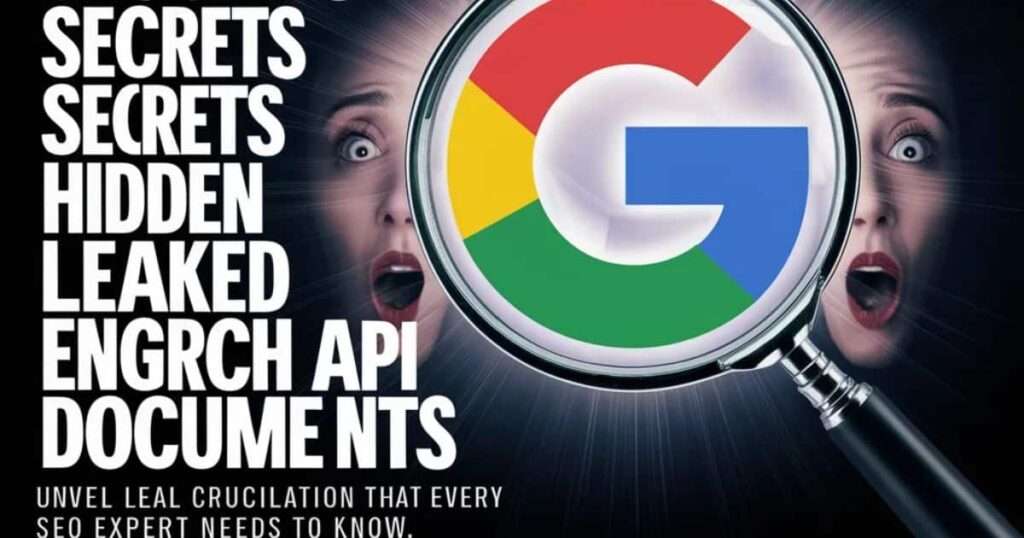In a shocking revelation, thousands of pages of internal Google API documentation were leaked, exposing closely-guarded secrets about how the world’s dominant search engine operates.
And it was none other than Rand Fishkin, co-founder of Moz and renowned SEO expert, who obtained these explosive files from an anonymous source.
What makes this leak so extraordinary? For years, Google has vehemently denied using user signals like click data and engagement metrics to rank websites.
The leaked API docs, however, tell a very different story – one that SEOs, digital marketers, and anyone invested in organic search cannot afford to ignore.
The Whistleblower and the Leaked Documents
Let’s start with some background on how this industry-shaking leak came to light. Rand Fishkin is a pioneering figure in the SEO world, having co-founded Moz (formerly SEOmoz) in 2003. Over 15 years, he helped grow Moz into a leading SEO software company with over 35,000 customers before departing in 2018.
His credibility in the search marketing space is undeniable:
- Author of influential books like “Lost and Founder” and “The Art of SEO”
- Featured in publications like the Wall Street Journal, Forbes, and the New York Times
- Cited by the US Congress, FTC, and popular shows like Last Week Tonight
- Creator of the Domain Authority metric widely used by SEOs
So when Fishkin received an email in May 2024 from someone claiming to have thousands of leaked Google API documents, he was understandably skeptical. But after verifying details with ex-Googlers and conducting a video call with the anonymous source, the authenticity of the leak became apparent.
“Nothing I saw in a brief review suggests this is anything but legit,” one former Google employee told Fishkin about the API documentation.
Inside the Leaked Google API Content Warehouse

But what exactly is this “API Content Warehouse”? As Fishkin explains, it’s essentially an inventory of data elements available to Google’s search engine team – a reference library of sorts that catalogues various inputs, processes, and features the company’s engineers can utilize.
While it doesn’t show the exact weightings of ranking factors, the 2,500+ pages offer an unprecedented glimpse into what types of data Google collects and how that data is employed to power its search algorithm.
To seasoned SEO professionals, some of the revelations may not come as a total shock. After all, many have long suspected Google uses click data, engagement metrics, and machine learning to fine-tune its search results. The leaked docs, however, provide concrete evidence that this is indeed happening behind the scenes.
As Mike King, founder of iPullRank, stated in his initial analysis of the leak:
“This appears to be a legitimate set of documents from inside Google’s Search division, and contains an extraordinary amount of previously-unconfirmed information about Google’s inner workings.”
So let’s dive into some of the key revelations from the leaked API docs and why they matter so profoundly for the SEO community.
1. NavBoost: How Google Uses Clicks, Engagement & User Data
One of the most damning elements exposed is Google’s apparent use of a system called “NavBoost.” This appears to gather data on:
- Clicks on search results
- Long clicks vs. short clicks (dwell time/bounce rate)
- Impressions (how often a page shows in search results)
References are made to metrics like “goodClicks,” “badClicks,” “squashed vs unsquashed clicks,” and others that seem to indicate Google finds ways to filter out clicks it deems problematic or invaluable.
As evidence of NavBoost’s significance, consider this 2019 email quote from Alexander Grushetsky, a Google VP:
“We already know, one signal could be more powerful than the whole big system on a given metric. For example, I’m pretty sure that NavBoost alone was / is more positive on clicks (and likely even on precision / utility metrics) by itself than the rest of ranking.”
And in cross-examination from the Google/DOJ case, Pandu Nayak, Google’s VP of Search Quality, acknowledged the role of both NavBoost and another system called “Glue”:
Q: “Together they help find the stuff and rank the stuff that ultimately shows up on our SERP?” Nayak: “That is true. They’re both signals into that, yes.”
So despite years of denials from Googlers that click data isn’t used for rankings, this leak confirms it plays a pivotal role through systems like NavBoost.
2. Tracking Chrome User Clickstreams
Another bombshell revelation? Evidence that Google tracks user clickstream data through its Chrome browser to gather signals for search rankings.
Think about that for a moment – the clicks and engagement metrics of billions of Chrome users worldwide are seemingly being hoarded by Google and fed into its search algorithms.
The leaked docs point to metrics calculated from “chrome_trans_clicks” and references to Google consuming full clickstream data from large swaths of internet users.
As Fishkin notes, this aligns with the anonymous source’s claim that a motivation for creating Chrome was to gain access to more user clickstream data to improve search.
Specific examples cited include how Google determines which URLs to feature in slighted links by looking at the “top urls with highest…chrome_trans_clicks.”
In other words, Google is studying what webpages users frequently click on for certain queries, then prioritizing those pages to show as sitelinks. It’s a clear example of how user signals directly influence a search feature’s results.
3. Travel, COVID & Election Whitelists/Blacklists

Among the most concerning takeaways is apparent evidence of whitelists and blacklists Google uses for queries related to:
- Travel
- COVID-19
- Elections
A module called “Good Quality Travel Sites” suggests a whitelist of approved domains exists for travel-related searches. Coupled with references to flags for “isCovidLocalAuthority” and “isElectionAuthority,” it seems Google is intentionally prioritizing or demoting certain sites when it comes to sensitive topics like public health and democratic processes.
While some may see this as responsible behavior from Google, it does raise questions about transparency and editorial curation – especially regarding an industry that generates billions for Google annually.
As Fishkin summarizes:
“Google would almost certainly be one of the first places people turned to for information about this event, and if their search engine returned propaganda websites that inaccurately portrayed the election evidence, that could directly lead to more contention, violence, or even the end of US democracy.”
This level of curation and gatekeeping is a stark contrast from Google’s once-utopian “organizer of the world’s information” mission. Regardless of where one stands, it’s a significant revelation about how the search engine now operates.
4. Factoring in Quality Rater Data
Another previously-opaque area pulled back the curtain? Google’s use of data from its Quality Raters program to influence rankings and quality assessments.
For years, Google has had vetted contractors and employees rate websites on quality signals like expertise, authoritativeness and trustworthiness as part of its search quality improvement efforts. What wasn’t known is whether (and how) this data directly fed back into Google’s core ranking systems.
The leaked API docs suggest these quality ratings play a material role, with references to features like:
- “Per document relevance ratings” from quality raters
- “Human ratings (e.g ratings from EWOK)” integrated into pipelines
This implies Google doesn’t just use quality rater data for evaluating potential search improvements, but also as live ranking factors factored into its algorithms.
It’s a significant revelation about how Google’s army of human raters, and their qualitative assessments, hold tangible sway over what websites show up in search results.
Read this Post: CATAZ NET: REVOLUTIONIZING ONLINE STREAMING IN USA
5. Using Clicks to Weight Inbound Links
Here’s another eye-opening claim stemming from Fishkin’s anonymous source:
Google sorts its link indexes into three tiers – low, medium and high quality. Where a website’s links get bucketed depends on the click data associated with those pages.
Per the leak, a website like “Forbes.com/Cats” with little click activity would land in the low-quality tier where its links get essentially ignored for passing ranking signals.
But a popular URL like “Forbes.com/Dogs” with high clickthrough rates from verifiable users would go into the high-quality bucket, boosting its link equity.
In essence, Google is using click data as a way to automatically score the quality of links and determine how much ranking power they hold. It’s an ingenious method of separating aggressive or spammy link acquisition from naturally popular pages worthy of prized link equity.
This is just one specific example, but it provides a window into how Google deftly combines traditional signals like links with their colossal bank.
The Bigger Picture for SEOs and Marketers
While the leaked API docs unveil many fascinating technical details, it’s important to step back and consider the bigger strategic implications for SEOs, digital marketers, and website owners. A few key takeaways:
Brand Equity Matters More Than Ever
One overarching theme becomes clear – Google heavily favors established, popular brands that create measurable “demand” and engagement among web users. As Fishkin bluntly states:
“If there was one universal piece of advice I had for marketers seeking to broadly improve their organic search rankings and traffic, it would be: ‘Build a notable, popular, well-recognized brand in your space, outside of Google search.'”
The days of bootstrapping a new website through clever on-page optimization and link building alone appear to be waning, if not already over. User signals like clicks, engagement metrics, and brand awareness are pivotal factors Google relies on to rank websites.
This privileging of brands has been accelerating, as data from companies like Edelman and Ahrefs illustrate. By some measures, nearly two-thirds of all Google traffic goes to the Top 20 websites for any given search.
“E-E-A-T” Principles May Be Overblown
For years, SEOs have stressed the importance of building “Expertise, Authoritativeness, and Trust” (E-A-T) as a core strategy for achieving high search rankings. However, the leaked docs cast doubt on whether these principles truly translate into distinct, heavily-weighted ranking factors.
Fishkin remarks candidly:
“I’m a bit worried that E-E-A-T is 80% propaganda, 20% substance. There are plenty of powerful brands that rank remarkably well and have very little expertise, experience, authoritativeness or trustworthiness.”
While editorial signals and reputation likely play some role, they may matter far less than once believed – especially compared to brand dominance and prevalence in click data.
On-Page Optimization is Table Stakes
With the rising importance of off-site user signals like clicks and engagement, traditional on-page SEO is no longer a sustainable path to prominent search visibility. As Fishkin notes:
“Even if an authoritative site like Wikipedia invested heavily in link building and content optimization, it’s unlikely they could outrank the user-intent signals of Seattle’s theatre-goers looking for information on the ‘Lehman Brothers’ play.”
On-page optimization is still a prerequisite, of course. But it is now merely “table stakes” – the minimum to get in the game before more powerful off-site factors determine winners.
So while technical SEO, keyword research, and high-quality content remain essential, they cannot be a sole focus. Top brands effortlessly attract links and engagement, so new sites must find ways to similarly build a loyal audience independent of search engines.
The Playing Field Isn’t Level
Like it or not, Google wields immense control over what content is discoverable through search. The apparent use of whitelists/blacklists for categories like travel, health, and politics concentrates that power even more.
While some may applaud measures to combat misinformation, it underscores how Google functions more as an editorial gatekeeper than a neutral information organizer. Smaller, less-established publishers may face unfair disadvantages compared to Google’s hand-picked domains.
There are no easy solutions here. But as web creators and marketers increasingly rely on Google as a primary traffic source, the lack of transparency raises justifiable concerns around censorship and fairplay.
In summary, this monumental leak has sobering implications for the SEO industry and web at large. Thriving in Google’s increasingly user-focused, brand-prioritized world will require rethinking many established practices and mindsets.
What’s Next – Continuing Analysis

The leak covered in this article represents just the tip of the iceberg. At over 2,500 pages and 14,000+ features, there is vastly more information to unpack than any single analysis could cover comprehensively.
Fishkin has stated that the renowned Mike King of iPullRank will take a deeper technical dive at the upcoming SparkTogether conference in October 2024. King’s initial review hinted at even more explosive revelations:
“This appears to be a legitimate set of documents from inside Google’s Search division, and contains an extraordinary amount of previously-unconfirmed information about Google’s inner workings.”
Other search industry players and data scientists will undoubtedly scrutinize the API documentation extensively. With Google controlling over 90% of the search market, any insights that pull back the curtain on its operations are invaluable for websites striving to remain visible and competitive.
For SEOs and marketers, this leak underscores an uncomfortable truth – we know far less about Google’s ranking systems than we’d like to believe. Overreliance on Google’s carefully-massaged public statements and patent filings has clearly led the industry astray in many regards.
As Fishkin implores:
“When those new to the field read publications that cover the SEO field’s news, they don’t necessarily know how seriously to take Google’s statements. Authors should not presume that readers are savvy enough to know that dozens or hundreds of past public comments by Google’s official representatives were later proven wrong.”
This leak is a wakeup call for SEOs and digital marketers. No longer can we blindly trust the narrative spun by Google’s PR and outreach teams. A new level of scrutiny, skepticism, and commitment to independent analysis is required.
The search industry as a whole must hold Google to a higher standard of transparency and accountability. As a quasi-public utility responsible for facilitating global information access and billions in commerce, Google’s days of obfuscation and misdirection should be coming to an end.
Thanks to this anonymous whistleblower and tireless advocates like Fishkin, the world finally has a candid look under Google’s hood. What we choose to do with these revelations will shape the trajectory of SEO, digital marketing, and perhaps the open web itself for years to come.
The data is out there – it’s up to us to read between Google’s lines and optimize accordingly.

Dennis, a seasoned tech professional with 5 years of expertise in the field. With a passion for innovation, he’s dedicated to delivering cutting-edge solutions through our website.







